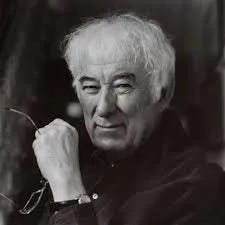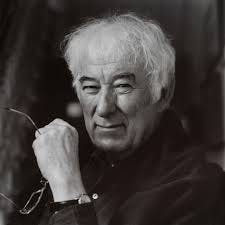
Seamus Heaney had been dead 3 years when I first encountered him. I was 15 in a classroom packed with inspiring posters and uninspired teenagers, thirty of us and few interested in poetry. Our teacher was explaining that 'Stormont,' the name of the Northern Irish Parliament building, was hidden in the title of 'Storm On The Island.' We spent the rest of the hour decoding Heaney's poem, teasing out hidden meanings, highlighting references to power and conflict, salvaging exam quotes from the worthless wreck of literature. It was poetry reading as cryptic crossword solving. It was not the best use of an afternoon.
I am grateful for that class and teacher, though, because in the years to follow I fell in love with Heaney. Here was a man who crowned frogs 'great slime kings,' who called the surface of water ‘the pane of a flood’, and who opened Beowulf with a nonchalant 'So.' His poems are cairns for me now - a favourite memory from a ruinous stretch of third year is sitting on my uni room's windowsill reading Station Island as the chapel choir limbered up. He has taught me so much. With Carol Ann Duffy, he taught me how to weave my words with musicality. With Mary Oliver, he taught me how to attend to the natural world. With Kym Deyn, he taught me how to spin quick wit. And with W.H. Auden, he taught me that poetry makes nothing happen - it is way of happening in itself.
Heaney begins this poem in an uncharacteristically teachery-tone. 'And then there was St Kevin,' he starts, and you can see Sunday slipping away beyond the church hall blinds. 'And then' does the heavy lifting here; the continuation of a lecture, a Biblical rhythm. Lessons on medieval saints are fun for those mad enough to take a Masters in the topic (shout out to Conrad's Angels if you're reading!), but dull if you're a young Catholic child being lectured by a nun. Don't worry, though. Heaney won the Nobel Prize a year earlier. He knows your attention is waning so he sprinkles in a magic trick. 'The saint is kneeling, arms stretched out...' Do you see it? We moved from 'was' to 'is.' Between line 1 and 2, a miracle occurs: the Saint comes suddenly to life.
We believe the animation because Heaney backs it up with language that feels. The poem is 24 lines split into two sections of four tercets each, and the whole first half is devoted to making this moment tangible. As icon-makers once lovingly gilded the faces of saints, Heaney gives us a goldleaf of words to bring every sensation into resolution. Kevin's own body is 'stiff', the bird's head and claws are 'tucked neat', the eggs are 'warm.' These are descriptions chosen to emphasise corporeality and materiality; tell me you can't picture it in your mind, feel it in your own upturned palm. And all of this is washed down with Heaney's signature musicality. ‘Inside / his cell, but the cell is narrow, so...’ The tightness of space caught in the tightness of sound; has claustrophobia ever been conveyed so lovingly?
Yet what makes the poem so delicious to me is that, after spending four careful tercets immersing us in the lived and living reality of the saint, Heaney rips the rug out and reveals it all as artifice. 'And since the whole thing's imagined anyhow.' I love the first and last words of this line. Again we have a section opening with 'And,' but Heaney obliterates the lecturing preachiness we saw it wear in line 1 with that gorgeously colloquial 'anyhow.’ You can see the flippant shrug as he dismisses the miracle story as that 'whole thing.' We're not at Sunday School anymore, we're hanging out with our cool poet friend who, knowing we're fully in on the silliness of it all, thinks it's time to take some creative licence.
In doing so, the line gets at a bigger point about the veracity of St Kevin, both within and beyond this poem. The Lives of Saints are part of a genre we call hagiography. Medieval scribes churned these out, using the biographies of important figures in the history of their church, monastery or parish to justify certain arrangements in their present (e.g. 'The Cathedral of Tours is worthy of its power and wealth now because St Martin of Tours cast out a demon called Wiggo there once'). It is unclear if we are meant to read hagiographies literally - is it really telling you St Martin cast out Wiggo, or that St Kevin cradled a blackbird? Or is it talking symbolically, that St Martin overcame sin and that St Kevin attended to nature? Hagiographies purposefully straddle a line between recounting history and inventing legend, imbuing the past with myth and fable in order to explain or justify the present. This is not a failure of historical record keeping, but rather an alternative form of memory - one concerned with the meaning of events, or ideas, or legacies, rather than their specifics or their truth.
That neither Heaney nor hagiographer cares whether you can trust their accounts is clear from how the second half continues. 'And since the whole thing is imagined anyhow, / imagine being Kevin.' Two important things happen in those three new words. First, Heaney, having admitted it’s all a story, invites you to join in with the fiction. Imagine – fabulate, speculate, make up! Second, Heaney drops the ‘St.’ The first section insists on formal respect for a holy figure. The second invites us to consider a man. Not a real man, not even an important man. Just a man who does something wonderful. Imagine it was possible to be this person, who can so easily care. What would that be like?
Taking up this invitation destabilises the poem. Gone are the declarative statements. The fifth, sixth and seventh tercets swell into a wellspring of question marks - six, in fact, that try once more to engage imaginatively with Kevin's material experience. ‘Are his fingers sleeping? Does he still feel his knees?’ These images are bodily; we can feel them in ourselves, we can imagine them in the dark and cold of a holy man's cell. But these images are not fixed. Note the open-endedness. Heaney is not telling us these things anymore, he's asking us about them. In doing so, he makes us conscious of our complicity as readers in bringing Kevin into life, into existence. He invites us to engage fully in the ultimate practice of empathy: sharing in the physical reality of an imaginary man.
And so poem and hagiography become more than historical source or objective record. Heaney reveals the story of Saint Kevin and the Blackbird not as a chapter of Christian history, but as the feat of imagining an act of care rooted in complete selflessness. It is an act that destroys both self and other - 'forgotten name, forgotten bird' - in order to create something bigger: 'the network of eternal life’. Whether this is possible or conceivable does not quite matter, whether it literally happened once is irrelevant. The poem, and the hagiography, is a space in which it could happen, a reworking of time to create possibility. Heaney is giving us the opportunity to imagine something bigger than ourselves here, and if we can imagine such care, if we can hold in our minds such love, if we can bring into our bodies such wonder, we might be able to embody these virtues in the real world and make the imaginary possible.
Earlier on, I referenced W.H. Auden's idea that poetry makes nothing happen. This is not a revelation to a class of thirty uninspired teenagers. What we didn't know in that classroom, however, is how that idea continues. Poetry, Auden writes, 'survives, a way of happening, a mouth.' Poets, like hagiographers, are not photographers. They don’t aim to produce records of exactly what happened. They aim to create moments and spaces for moments that have their own internal rules and power. Sometimes this reveals things about the real world, as Nicholson captured snippets of Millom or Limón responds to the anthropocene. It is inevitable that poems trap language and references and understandings and attitudes, and historians and scholars can have great fun untangling these to open windows on the past, just as my friends and I used to do with medieval hagiographies. But a poem doesn’t end in its communication of the real world. If I could return to that classroom, here is what I would whisper in our ears:
A poem begins with the world it makes possible.
Next week: What does a cathedral know?
I refer to Kevin as a medieval saint, but as ever in history, periodisation is funky. We’re told Kevin of Glendalough was born in 498CE and died in 618 CE. The hagiography we know him from is part of the Acta Sanctorum Hiberniae, written in 1645, over 1000 years later. Moreover, Kevin wasn’t officially canonised by the Catholic Church until 1903! That’s 1,505 years after he was born, a long way from medieval. This is one of the reasons, as a historian, I loved the saints. You try to pin them down to an era, but they keeping wriggling out of the past and into unexpected futures. They make merry with time.
The Auden poem referenced here is ‘In Memory of W.B. Yeats.’ Grappling with Yeats’ death, Auden writes that ‘he became his admirers.’ There’s something very hagiographical in this resurrection through reading. How else could a class of thirty students encounter Heaney three years after his death?
I can’t tell you how I’ve enjoyed thinking about how history works again - poetry, saints and time in the same essay? A homecoming!





Your passion for these topics really shone in today's post, it brought a genuine smile to my face quite a few times as I read!
I love this interpretation of poetry as a literary diorama - presenting a whole little world with its own rules and lore all on just a few pages. Your exploration of how this poem does an exceptionally good job at exactly that through Heaney's use of vivid descriptions was inspiring.
I learned quite a bit of new information from today's entry as well; I never knew there was an official name for the recording of saints' lives! And interpreting hagiographic literature as less literal and more symbolic gives it a new, more fantastical (but at the same time more realistic) light: once you've accepted that the message isn't that someone actually held his hand out for a blackbird for a quarter of a year until her eggs had hatched and the young had flown the nest, you open yourself up to receive a message that has direct meaning to you personally and has real-world applications.
Thank you for this week's Friday reading! 😁
- J